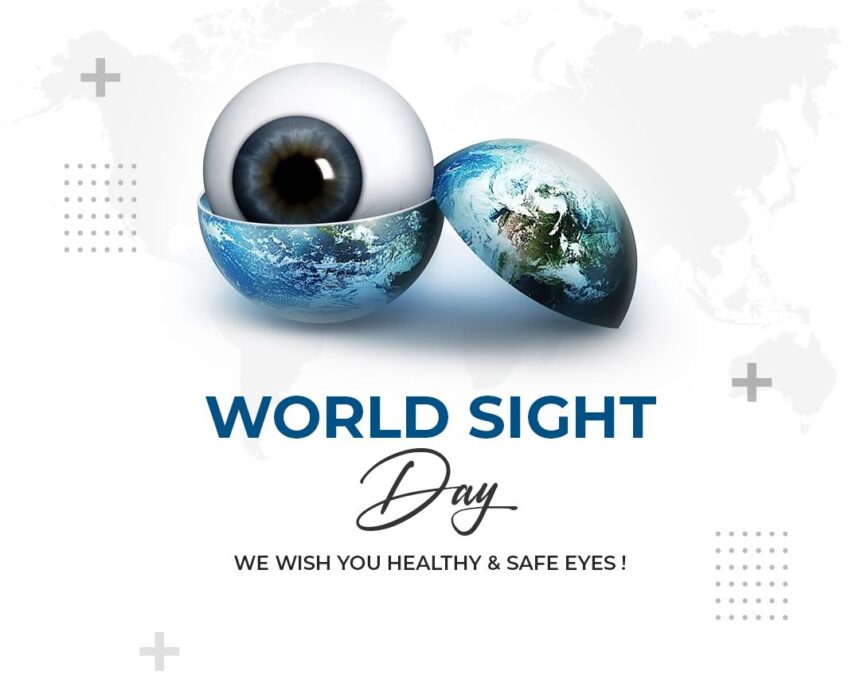👁️ 7 Eye-Opening Truths About World Sight Day That Will Change How You See the World
🧭 Introduction: The Power of Vision in a Visual World
Imagine waking up and not being able to see the sunrise, your loved ones, or the face of a child smiling. Our eyes are the window to the world, yet many of us take good vision for granted—until it’s gone.
That’s why World Sight Day, observed globally on the second Thursday of October every year, exists. It’s a day dedicated to raising awareness about blindness and vision impairment, encouraging access to eye care, and promoting eye health as a fundamental human right.
- 🗓️ Timeline of World Sight Day
- 📖 History of World Sight Day
- 📌 Key Facts About Vision & World Sight Day
- 🌟 7 Eye-Opening Truths That Make World Sight Day Crucial
- 1. 💡 Vision Impacts Everything—Literally Everything
- 2. 🧠 90% of Vision Loss Is Preventable
- 3. 📵 Screens Are the New Silent Threat
- 4. 🧒 Kids Need Eye Checks More Than Ever
- 5. 🧓 Ageing Doesn’t Have to Mean Blindness
- 6. 🧑⚕️ Vision Inequality Is Real and Urgent
- 7. 🌍 Eye Health Is a Human Right
- 🎉 How Is World Sight Day Observed?
- ❓ Frequently Asked Questions (FAQs)
- Q1: When is World Sight Day 2025?
- Q2: What is the goal of World Sight Day?
- Q3: Who organizes it?
- Q4: How can I participate?
- Q5: Is vision loss always permanent?
- 💬 Wishing Messages for World Sight Day
- 👀 Importance in Daily Life
- 📣 Societal Impact and Long-Term Benefits
- 🧠 Observance Significance
- 🧾 Conclusion: Vision Is a Gift—Let’s Not Waste It
The 2025 theme of World Sight Day is:
“Love Your Eyes at Work”, reinforcing the importance of eye health in daily life and workspaces.
🗓️ Timeline of World Sight Day
| Year | Event |
|---|---|
| 1998 | World Sight Day launched by the Lions Clubs International Foundation |
| 2000 | Adopted globally under Vision 2020: The Right to Sight initiative |
| 2009 | Integrated into the WHO and IAPB global action plan |
| 2021 | Theme: “Love Your Eyes” campaign launched |
| 2025 | Focus on workplace eye health and digital screen awareness |
📖 History of World Sight Day
World Sight Day was originally started by the Lions Clubs International Foundation in 1998 as part of the SightFirst campaign, an effort to combat preventable blindness.
Later, the International Agency for the Prevention of Blindness (IAPB) joined forces with the World Health Organization (WHO) under the global initiative VISION 2020: The Right to Sight. The goal? To eliminate avoidable blindness by the year 2020 and beyond.
Now, World Sight Day has grown into a global movement, celebrated by NGOs, hospitals, universities, and governments across more than 100 countries.
📌 Key Facts About Vision & World Sight Day
👁️ Over 1.1 billion people globally live with some form of vision loss
🧑🦯 At least 90% of vision impairment is preventable or treatable
🌍 Asia and Africa account for the highest burden of avoidable blindness
📱 Digital screens are now one of the leading causes of eye strain
🧒 Children need regular eye exams as 80% of learning happens through vision
🧑⚕️ Lack of access to affordable eye care is the biggest barrier in many nations
🌟 7 Eye-Opening Truths That Make World Sight Day Crucial
1. 💡 Vision Impacts Everything—Literally Everything
From education to employment, safety to self-esteem, good eyesight determines our quality of life. Vision impairment not only affects individual potential but also places a huge economic burden on families and nations.
2. 🧠 90% of Vision Loss Is Preventable
Yes, you read that right. With simple eye exams, corrective glasses, and affordable surgeries (like for cataracts), most vision issues can be prevented or reversed. Yet millions suffer due to neglect or inaccessibility.
3. 📵 Screens Are the New Silent Threat
In today’s digital age, Digital Eye Strain (DES) or Computer Vision Syndrome is a rising concern. Blurred vision, dry eyes, and headaches are now common even among teenagers and professionals.
4. 🧒 Kids Need Eye Checks More Than Ever
Children often can’t express visual problems. Poor performance in school is sometimes just unrecognized nearsightedness. Regular eye tests can dramatically improve their development and learning.
5. 🧓 Ageing Doesn’t Have to Mean Blindness
Many older adults believe that losing vision is just a part of aging. But with proper eye care, conditions like cataracts, glaucoma, and age-related macular degeneration can be managed or even cured.
6. 🧑⚕️ Vision Inequality Is Real and Urgent
People in low-income countries, women, rural populations, and minorities often suffer more from avoidable blindness, simply because they lack access to affordable eye care.
7. 🌍 Eye Health Is a Human Right
The United Nations now recognizes eye health as essential to the Sustainable Development Goals (SDGs). World Sight Day supports the idea that “Everyone deserves to see.”
🎉 How Is World Sight Day Observed?
👓 In Healthcare
Free eye check-up camps in hospitals and rural areas
Awareness sessions on eye diseases and care
Vision screenings for school children and factory workers
🌐 In Society
Walkathons and “Blindfold Challenges” to create empathy
Public seminars and TV/radio campaigns
Social media drives with hashtags like #WorldSightDay #LoveYourEyes
🧑🏫 In Schools & Colleges
Poster, essay, and drawing competitions
Seminars about screen-time and its impact
Donation drives for eyeglasses or eye surgeries
❓ Frequently Asked Questions (FAQs)
Q1: When is World Sight Day 2025?
October 9, 2025 (second Thursday of October every year)
Q2: What is the goal of World Sight Day?
To raise awareness about vision care, preventable blindness, and to encourage people to prioritize eye check-ups.
Q3: Who organizes it?
The event is spearheaded by the International Agency for the Prevention of Blindness (IAPB), with support from WHO and national organizations.
Q4: How can I participate?
You can get your eyes tested, donate to a vision charity, share awareness on social media, or help someone access vision care.
Q5: Is vision loss always permanent?
No. Conditions like refractive errors and cataracts are treatable. The key is early detection.
💬 Wishing Messages for World Sight Day
🕊️ “Let’s open our eyes to those who can’t. Happy World Sight Day!”
🌈 “This World Sight Day, may we all learn to see with compassion and act with vision.”
👁️ “Take care of your eyes—they show you the world and the ones you love.”
🧑⚕️ “Wishing you clear vision and healthy eyes. Celebrate World Sight Day by caring for your sight!”
👀 Importance in Daily Life
Helps prevent conditions like blindness, myopia, cataracts
Boosts education, especially for children with undetected issues
Supports safer driving, reading, and working
Encourages people to adopt healthy digital habits
Prevents chronic headaches, fatigue, and poor productivity
📣 Societal Impact and Long-Term Benefits
✅ Health & Productivity
Reduces national healthcare burden
Increases workforce participation
Improves learning outcomes and economic potential
✅ Economic Growth
Studies show that correcting vision improves GDP growth
Lower costs for long-term disability and assisted care
✅ Inclusion & Empowerment
Visually impaired people can thrive with adaptive tools and resources
Education and jobs become accessible when vision is restored
🧠 Observance Significance
Reminds us that eye health is not optional—it’s essential
Encourages annual checkups for proactive prevention
Drives policy for universal eye care in public health systems
🧾 Conclusion: Vision Is a Gift—Let’s Not Waste It
On World Sight Day, we don’t just focus on blindness—we focus on the power of sight, the gift of perspective, and the urgency to act before it’s too late.
Vision brings the world into focus—your family, your dreams, your future. Let’s ensure every human being has the right to see clearly, regardless of where they live or how much they earn.
So take this moment to love your eyes. Because your vision doesn’t just help you see—it helps you live fully.








